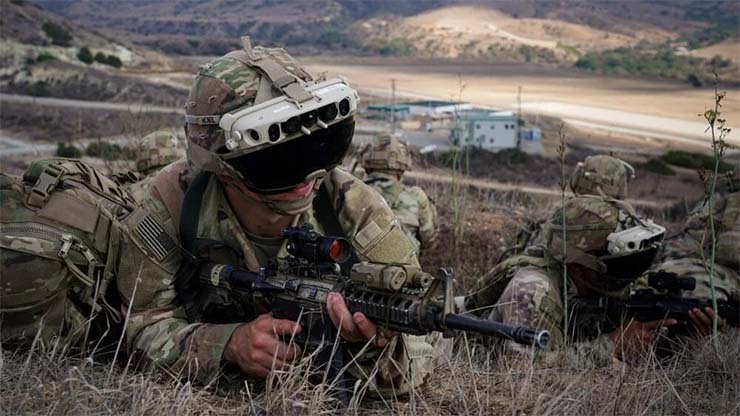
Washington: Even as keeping China in check in the Indo-Pacific region was the top priority for the US, the Ukraine invasion by Russia gave the American Army leaders an opportunity to tout the service’s role supporting allies and partner nations via training and weapons deliveries.
Although Army leaders faced a confluence of challenges in 2022 including a recruiting shortfall, problems with military housing and accusations of “wokeness,” the year also saw the effectiveness of Army-centric weapons like the M142 High Mobility Artillery Rocket System (HIMARS), Javelin man portable, anti-tank system, and the Stinger anti-aircraft missiles on today’s battlefield.
“You don’t need armour if you don’t want to win,” Army Chief of Staff Gen James McConville told reporters during an October 10 press conference when asked about lessons learned from the war and future of the M1 tank.
“You never want to present your adversary with one dilemma… if you just push tanks at them,” those can be defeated just like Russian tanks inside of Ukraine, he added. “That’s why you want infantry, you want armour, you want attack aviation, you want [long-range] fires [and] intelligence. All those systems working together.”
The year 2022 provided the service an opportunity to reassert its contribution to the joint force, and allies and partners, but with that opportunity the service also faced practical challenges like backfilling its weapons stockpile. To do this, the Army issued a variety of contracts, including one for $14.4 million to Lockheed Martin for the company to bolster its HIMARS production capacity. Another contract soon followed in December for an additional $431 million for Lockheed to produce these additional launchers.
“This award will enable us to replenish our own inventory while providing critical capabilities for our allies and international partners,” Douglas Bush, the Army’s Assistant Secretary for Acquisition, Logistics and Technology, said in a December two announcement.
In the same vein, the service also awarded the Javelin Joint Venture between Raytheon Missiles and Defence and Lockheed with a $311 million contract in September for the production of more than 1,800 Javelins.
Although lots of money was funnelled towards the Ukrainian-Russia war this year, Army leaders did move forward with developing a variety of new platforms while also changing course on others. Several Army ground vehicle programs entered new phases this year, while others were stopped in their tracks.
BAE Systems was also competing for the Mobile Protected Firepower (MPF) contract with a lighter prototype crewed by three soldiers, but it was disqualified earlier in the year due to undisclosed noncompliance issues.
However, 2022 wasn’t all bad news for BAE as the Army selected its Beowulf as its new Cold Weather All-Terrain Vehicle (CATV) and provided BAE with a seven-year, $278 million production contract.
BAE also delivered at least 130 Armoured Multi-Purpose Vehicles (AMPVs) to the Army by early October, and the first Army unit is set to begin training with the vehicles in January 2023, Program Executive Officer for Ground Combat Systems Major General Glenn Dean, told reporters at the time.
The US Army decided to hold off on pursuing a Robotic Combat Vehicle-Medium (RCV-M) fleet this year and said it will instead first focus on developing an RCV-Light (RCV-L) line. Under this new multi-pronged approach, the service will continue experimenting with the RCV-L prototypes it acquired from QinetiQ North America and Pratt Miller (now owned by Oshkosh Defence) based on a “variant” of the Expeditionary Modular Autonomous Vehicle (EMAV).
The Army is seeking a modified commercial off-the-shelf Common Tactical Truck (CTT) fleet to perform missions currently conducted by Palletized Load System A1 vehicles, Heavy Expanded Mobility Tactical Trucks (HEMTT) A4, M1088 Tractors, and M915 Line Haul Tractors. Eventually, a final down select could lead to a $5.1 billion production contract for 7,265 vehicles.
After a multi-month delay this year, US Army acquisition officials announced in December that Bell Textron’s V-280 Valor tilt rotor had edged out Sikorsky-Boeing’s coaxial rotor Defiant X, and will continue on in Future Long-Range Assault Aircraft (FLRAA) development.
“We were seeking the best value approach,” Maj. Gen. Robert Barrie, the Army’s Program Executive Officer for Aviation, told reporters on December five.
Bell has now received a deal worth up to $1.3 billion with the initial obligation valued at $232 million over the next 19 months. These initial dollars will enable the company to continue working on the preliminary design of the aircraft and deliver “virtual prototypes of a potentially model-based system,” Barrie said.
In addition to Valor decision, the service continued developing several missiles this year including Lockheed Martin’s Precision Strike Missiles (PrSM) and awarded the company with a $158 million contract to produce additional early operational capability missiles.
For boosting the weapons for individual soldier, the service announced several key acquisition decisions including awarding Sig Sauer with a 10-year contract valued up to $4.7 billion for its Next Generation Squad Weapon (NGSW) program. The company’s offering will now be the XM5 NGSW-Rifle (NGSW-R) to replace the M4/M4A1 carbine weapon and the XM250 NGSW-Automatic-Rifle (NGSW-AR) to replace the close-combat force’s M249 Squad Automatic Weapon in the Automatic Rifleman role. The service also selected the company’s 6.8 mm ammunition for the program.
If the program proceeds as planned, close-combat soldiers will begin receiving these new 6.8 mm caliber rifles and automatic rifles in late 2023.
The Army and Microsoft also moved ahead revamping and testing the Integrated Visual Augmentation System (IVAS) this year — a militarized version of the HoloLens 2 heads-up display. However, soldiers continued to experience physical ailments when using the device during operational testing this summer.








